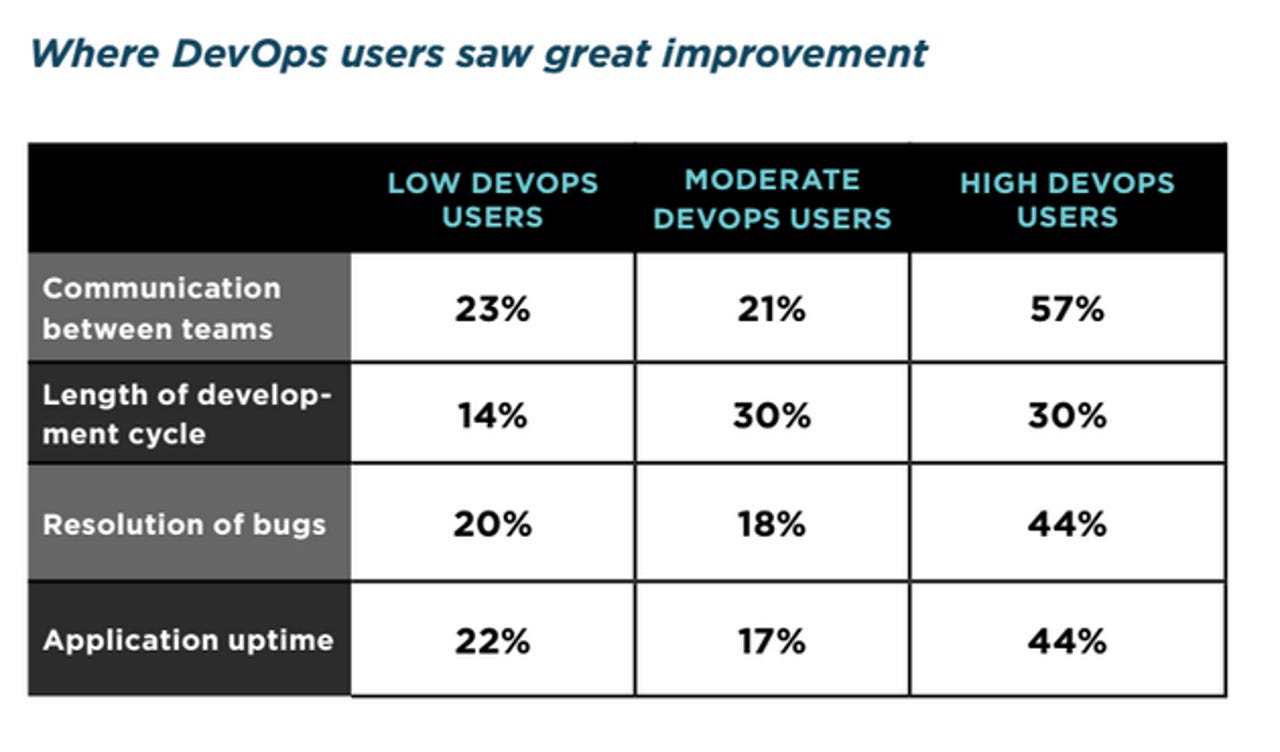To get the most out of devOps, go all in, survey suggests

Adopting devOps strategies help organizations release code faster and more frequently, according to a new survey of IT professionals in the US and Europe. While that's not exactly surprising, the survey also suggests that organizations are best off taking an all-in approach to devOps -- and that partial devOps adoption could actually be counterproductive.
For instance, 44 percent of respondents with high devOps adoption saw an improvement in the resolution of bugs, while just 18 percent of respondents with moderate devOps adoption said they saw an improvement. That number was slightly higher, at 20 percent, for low devOps users.

Featured
Similarly, the survey showed that low devOps users reported slightly better results than moderate devOps users when it came to communication between teams and application uptime. High devOps users reported much better results in both categories.
When it comes to development lifecycle, both high and moderate devOps users reported better results than low devOps users.
The survey, commissioned by digital intelligence firm New Relic, examined responses from more than 500 IT professionals in large and small enterprises across the US and Europe.
"The message is clear: effective DevOps requires an all-in approach," New Relic wrote in a report outlining the survey results. For example, the report points out, many organizations look to tools such as Jenkins to enable automation capabilities. However, it says, "a reliance on automation in lieu of modernizing organizational and measurement processes can stifle progress."
Meanwhile, the survey also confirmed devOps adoption goes hand-in-hand with the adoption of a more "dynamic" cloud strategy.
Respondents who said they took a dynamic approach to the cloud were deploying software more frequently: Almost half (49 percent) said they were deploying at least several times per week. Among static cloud users, only 41 percent were deploying with at least that frequency, and only slightly more than a third (35 percent) of traditional data center users did so.
The self-identified dynamic cloud users allocate resources automatically, based on their needs, explained Lee Atchison, New Relic's senior director for strategic architecture. They're using automatic scaling, dynamic routing and serverless technologies. Static cloud users, meanwhile, have taken the "lift and shift" approach of simply managing static resources on the cloud.
"What we found was not only were our assumptions basically true but probably more true than we thought, as far as the value of using the dynamic cloud," Atchison said of the survey.
The survey found that respondents who embraced the dynamic cloud saw more improvements across multiple metrics including application uptime, client satisfaction, length of development cycle, and operating costs.
Not surprisingly, dynamic cloud users have moved more of their strategic workloads to the cloud than static cloud users. Some 82 percent of dynamic cloud users have an equal mix of strategic workloads running in the public cloud and in private data centers, versus just 19 percent of static cloud users and 14 percent of traditional data center users. About half (51 percent) of static cloud users still run most of their strategic production workloads in a private data center.
While dynamic cloud users often split workloads between the public cloud and private data centers, most (59 percent) plan to shift the majority of their strategic workloads to the public cloud. Additionally, 45 percent of static cloud users and 21 percent of traditional data center users say they plan to move most of their strategic workloads to the public cloud.
Atchison said the survey results should help inform New Relic's conversations with customers as they consider how to best utilize the cloud.
"Companies with no cloud experience, by moving to a static cloud model, they're at least gaining cloud experience, and that's helpful to them later," he said. However, he added, "The advantages of cloud don't show up nearly as much in the static model."